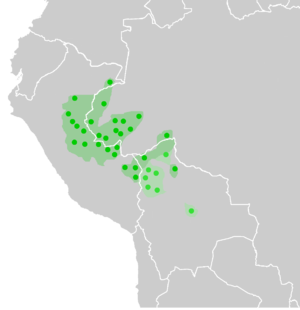Pano-Tacanan (also Pano-Takana, Pano-Takánan, Pano-Tacana, Páno-Takána) is a proposed family of languages spoken in Peru, western Brazil, Bolivia and northern Paraguay. There are two close-knit branches, Panoan and Tacanan (Adelaar & Muysken 2004; Kaufman 1990, 1994), with 33 languages. There are lexical and grammatical similarities between the two branches, but it has not yet been demonstrated that these are genetic (Loos 1999).
| Pano-Tacanan | |
|---|---|
| (proposed) | |
| Geographic distribution | southern Amazon |
| Linguistic classification | Macro-Panoan ?
|
| Subdivisions | |
| Glottolog | pano1259 |
 Panoan languages (dark green) and Tacanan languages (clear green). Circles indicate locations of modern languages. | |
Most Panoan languages are spoken in either Peru or western Brazil; a few are in Bolivia. All Tacanan languages are spoken in Bolivia (Ese’ejja is also spoken in Peru).
Genealogical relations edit
Migliazza has presented lexical evidence in support of a genetic relationship between the Panoan and Yanomaman languages. He also suggests that a Panoan–Chibchan relationship is plausible.[1]
Jolkesky (2016) also notes that there are lexical similarities with the Arawakan languages due to contact.[2]
Comparison edit
Below is a list of lexical cognates shared between Proto-Pano and Proto-Takana, demonstrating the genetic relatedness of the Pano and Takana branches. The two branches also share many basic cognate grammatical morphemes.[3]
| gloss | proto-Pano | proto-Takana | proto-Pano-Takana |
|---|---|---|---|
| tree | *hiwi | *akwi | **hegwi |
| tooth | *ʂɨ- | *t͡ʂe- | **ʂɨ- |
| two | *ɾa-ßɨta | *beta | **bɨta |
| liver | *takwa | *takwa | **takwa |
| leaf | *pɨɁi | *pei ‘to fan’ | **pɨɁi |
| bone | *ʂao | *t͡ʂau | **ʂau |
| tongue | *hana | *ana | **hana |
| hand | *mɨ- | *me- | **mɨ- |
| night | *(ya)mɨtV | *meta | **mɨta |
| skin | *ßitsi | *biti | **bitsi |
| fire | *tsiɁi | *ti | **tsiɁi |
| knee | *ɾã- | *da | **da-n |
| blood | *himi | *ami | **hemi |
| breast | *ʂo- | *aṭṣu | **aṣu |
| sun | *ßari | *badi ‘moon’ | **badi |
| I | *Ɂɨ | *e | **Ɂɨ |
| you (sg.) | *mi | *mi | **mi |
| come | *ßɨ- ‘come, bring’ | *be- ‘bring’ | **bɨ- |
| flesh | *nami | *ɾami | **Nami |
| fat (n.) | *ʂɨni | *ṭṣeri | **ṣɨNi |
| fingernail | *mɨ̃-tsis[i] | *metiji | **mɨ-tsizi |
| foot, leg | *ta- ‘foot’ | *ta- ‘leg’ | **ta- |
| lip, edge | *kwɨ- | *kwe(i)- | **kwɨ ~ **kɨ- |
| cheek | *tamo | *tamu | **tamu |
| mouth | *kwɨʂa[CV] | *kwat͡ʂa | **kweʂa |
| elbow | *βaȿ(u)- | *–batʂu | **baṣu |
| howler monkey | *ɾoʔo | *duʔu | |
| mother | *ɨwa | *e-kwa | |
| big | *ani | *aɾi | |
| flute | *ɾɨwɨ | *dewe | |
| hole | *kini | *kani |
Bibliography edit
- Adelaar, Willem F. H.; & Muysken, Pieter C. (2004). The languages of the Andes. Cambridge language surveys. Cambridge University Press.
- Campbell, Lyle. (1997). American Indian languages: The historical linguistics of Native America. New York: Oxford University Press. ISBN 0-19-509427-1.
- Kaufman, Terrence. (1990). Language history in South America: What we know and how to know more. In D. L. Payne (Ed.), Amazonian linguistics: Studies in lowland South American languages (pp. 13–67). Austin: University of Texas Press. ISBN 0-292-70414-3.
- Kaufman, Terrence. (1994). "The native languages of South America." In C. Mosley & R. E. Asher (Eds.), Atlas of the world's languages (pp. 46–76). London: Routledge.
- Suárez, Jorge A. (1973). Macro-Pano-Tacanan. In International Journal of American Linguistics, Vol. 39, No. 3, pp. 137-154. The University of Chicago Press. Accessed from DiACL.
References edit
- ^ American Indian Languages, Oxford Studies in Anthropological Linguistics, Campbell, Lyle, 2000.
- ^ Jolkesky, Marcelo Pinho de Valhery (2016). Estudo arqueo-ecolinguístico das terras tropicais sul-americanas (Ph.D. dissertation) (2 ed.). Brasília: University of Brasília.
- ^ Valenzuela, Pilar; Zariquiey, Roberto (2023-02-16). "Language classification in Western Amazonia: Advances in favor of the Pano-Takana hypothesis". LIAMES: Línguas Indígenas Americanas. 23. Universidade Estadual de Campinas. doi:10.20396/liames.v23i00.8670150. ISSN 2177-7160.
External links edit
- Proel: Familia Pano-Tacanana
- Proel: Familia Panoana
- Proel: Familia Tacanana